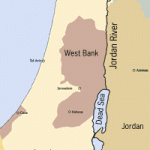
An Israeli general in wrap-around sunglasses climbed a rocky cliff and surveyed the Jordan Valley below. The river crawled like a lazy green serpent across a khaki desert, the valley floor dotted with Palestinian villages and Jewish settlements, and their fish ponds, mint greenhouses and plantations of date palm.
The general pointed to a fence in the distance, a picket of watch towers, a dusty road driven by an Israeli armored personnel carrier — and beyond it, Jordan.
It looked peaceful.
“Don’t be fooled,” Maj. Gen. Gadi Shamni said. “We would lose a lot if we leave here. Intelligence, deterrence, rapid response. A lot of capabilities, seen and unseen.”
For U.S. Secretary of State John F. Kerry to secure a peace deal between Israelis and Palestinians, the two sides must find compromise here in the Israeli-occupied Jordan Valley, a linchpin that has consumed months of study by retired Marine Gen. John R. Allen, a veteran former commander in Iraq and Afghanistan.

The Israelis are insisting that their troops remain in the Jordan Valley corridor in any future Palestinian entity, and since this demand is new — and was not a core issue in the last serious negotiations in 2000 and 2007 — it represents a real test for the Obama team’s diplomatic ingenuity.
Doubts, claims and promises
This is the valley the Bible says Moses looked across to see, but never reach, his promised land. In the minds of a generation of Israeli military planners and hawks in the Israeli government today, the Jordan Valley is an indispensable line of defense against threats from militant groups operating in the wider Arab world.
For Palestinians dreaming of a future state, the valley marks not a barrier, but a door — for trade and travel with Jordan and the wider world, without having to pass through a hated checkpoint manned by Israelis.
The details of Allen’s proposals have been kept secret, but the outlines are known. As described by Israeli military analysts and Palestinian officials, the plan envisions a limited number of Israeli troops — maybe 1,500 soldiers — remaining in the valley for 10 or 15 years, supported by top-shelf U.S.-supplied surveillance and intelligence technology. Palestinian security forces would get training and time to prove they can guard the border and watch Israel’s back.
Other ideas floated by the Allen team include an “invisible” Israeli presence at the border crossings to Jordan, manned by Palestinians but watched by Israelis remotely. Suggestions that U.N. peacekeeping or NATO forces would operate in the area are supported by the Palestinians, but Prime Minister Benjamin Netanyahu has said Israel will not subcontract its security.
Palestinians have been howling that Kerry and Allen are trying too hard to meet Israeli security demands.
“We know that Israel wants a permanent military presence in the Jordan Valley, which we will never accept. Never,” said Muhammad Shtayyeh, a former lead Palestinian negotiator who resigned in protest late last year. “But we are ready for incremental withdrawal. Let it take three years or four or five, no more, and after that, there should not be a single Israeli soldier nor a single Israeli settler. That will be over, done, finished.”
Palestinian Authority President Mahmoud Abbas has accused Israel of wanting its troops in the valley for 40 years.
The Israelis’ “claim that they want to protect their eastern border from Iran and others is all lies,” he told members of his Fatah political party recently.
Palestinian negotiator Saeb Erekat recently led a group of journalists and diplomats on a tour of the Jordan Valley. He said Israel reaps more than $600 million in revenue from valley agriculture.
“It’s not about security,” he told gathering, according to the Associated Press. “It’s about stealing land and profiting.”
For their part, right-wing leaders in Netanyahu’s coalition government want Israel to annex the entire Jordan Valley — about 25 percent of the West Bank — and never surrender it to the Palestinians.
Netanyahu’s deputy defense minister, Danny Danon, was in the valley last week planting trees and pledging the area will remain under Israeli control forever.
About 6,500 Jewish settlers live in a few dozen Israeli settlements in the valley; many are farmers whose families arrived after the 1967 war. Some 10,000 Palestinians live in agricultural villages, many tending their own crops or working for Israelis. About 50,000 Palestinians live in the ancient city of Jericho, which will remain in Palestinian hands under any scenario.
What will happen to the Israeli settlers is unknown. Abbas has said that in a future Palestine there would be no Israeli troops, no Israeli settlers.
“Anyone who wants peace,” said Aref Daragmeh, a Palestinian farmer and a community leader in the valley, “has to leave our lands.”
Today, Israeli troops patrol one side of the Jordan River, Jordanian soldiers the other. An Israeli military intelligence officer said in an interview that weapon-smuggling across the river into the Israeli-occupied West Bank is essentially nonexistent.
The valley is one of the most closely watched frontiers in the world, with some of the toughest border control anywhere. The Israelis erected early-warning towers atop the steep mountain tops and a “smart fence” bristling with cameras and radar. Israel controls not only the airspace here but also the electromagnetic space — the airwaves and cellular signals. They do not want to give this up.
The zone is so pacified that the Israeli Defense Forces have assigned a special brigade of ultra-Orthodox recruits to guard it — devoutly religious soldiers not especially celebrated here for their warrior spirit.
Anticipating the threats
Many Israeli security analysts today focus on the valley not as yesterday’s tank trap but as tomorrow’s firewall against asymmetrical threats — jihadists illegally entering the West Bank and delivering a shoulder-fired, anti-aircraft missile to down a commercial airliner at the airport in Tel Aviv.
If a peace deal is struck and the Jordan Valley given to a future Palestinian state, the debate among Israeli security officials then becomes all about “depth and duration,” meaning how many Israeli troops can remain, for how long and where.
Retired Maj. Gen. Giora Eiland, a former head of the Israeli National Security Council, said Israeli commanders would want a corridor five kilometers wide and 80 kilometers long, totaling 7 or 8 percent of the West Bank. He doubted that the Palestinians would accept it.
Israeli skeptics worry that a border guarded by Palestinians along the Jordan Valley will be porous and that Jordanian vigilance will flag.
Dore Gold, Netanyahu’s special foreign policy adviser and a former Israeli ambassador to the United Nations, said he imagined scenarios whereby a rearmed Iraq or an ascendent Iran could send an armored expeditionary force rolling across Jordan to attack Israel.
“Yes, Iraq has been defeated in two wars. Yes, Israel has peace with Jordan and Egypt. And Syria is in chaos. So where is the threat?” Gold said in an interview. “But can you guarantee that any of these states will be around in their current form in five years? In 10 years?”
Some Israelis also fear that after a peace deal is struck, the anti-Israel Islamist group Hamas could win elections and take control of the West Bank, as it did in the Gaza Strip eight years ago, and allow weapons to flow in.
“Then we would have to conquer this place all over again,” said Shamni, the Israeli general, noting that the whole point of the peace process is for that not to happen.
Washington Post

Leave a Reply
You must be logged in to post a comment.